Physical Address
304 North Cardinal St.
Dorchester Center, MA 02124
Pediatric arterial aneurysms include many rare and heterogeneic diseases. Etiologies vary widely among the different types of aneurysms, with important differences in the aneurysm’s character and clinical relevance often dependent on the specific vessel affected ( Table 186.1 ). Aneurysms in children, with few exceptions, should be considered dangerous. Although optimal management strategies and established criteria for operative treatment remain ill defined, rupture and thrombosis are reported frequently enough to justify early intervention in most cases. Unfortunately, children having an active systemic process responsible for their aneurysm carry the highest chance of rupture, but they are also at greatest operative risk. Many surgical procedures in the treatment of these aneurysms are complex, and management strategies based upon the specific arterial bed involved deserve individual review.
| Category | Arteries Commonly Affected | Aneurysm Characteristics | Clinical Manifestations |
|---|---|---|---|
|
Aorta, muscular arteries | Medial elastic tissue disorganization, cystic mucinous deposits, both solitary fusiform and multiple saccular aneurysms | Aortic rupture or dissection relatively common; arteriography |
|
Aorta, splanchnic, renal, iliofemoral arteries | Medial thinning and fibroplasia; solitary and multiple saccular aneurysms at arterial bifurcations | Usually asymptomatic, rupture uncommon, extremity aneurysms often present as painless pulsatile mass |
|
Aorta, iliac arteries | Acute inflammatory infiltrates, chronic fibrosis with saccular aneurysms | Contaminated umbilical artery catheterizations, bacterial endocarditis, rupture common |
|
Aorta, brachiocephalic, renal, splanchnic, iliofemoral arteries, coronary (Kawasaki Disease) | Acute necrotizing inflammation, chronic panmural inflammation with multiple saccular aneurysms | Constitutional symptoms common during active disease, aneurysms in quiescent phase usually asymptomatic |
|
Aorta, extremity arteries | Disruption of all three layers of artery (pseudoaneurysm), thrombosis of small aneurysms common | Protean manifestations, aortic aneurysms often rupture, peripheral aneurysms often asymptomatic |
Aortic aneurysms are classically defined as enlargement (dilation) of the aorta’s diameter greater than 1.5 times normal. Diagnosis of a pediatric aortic aneurysm requires a careful consideration of location and aortic size, for which standards are not well established. Nevertheless, useful data on aortic dimensions exist in two contemporary studies of normal pediatric aorta sizes by tomographic examinations based on a number of factors including age, gender, the site of aortic involvement, and body surface area. , These measurements have particular value in assessing suspected genetic etiologies of aortic aneurysms wherein the entire aorta may be dilated and a segment of normal aorta may be nonexistent to compare to the most aneurysmal site. Pediatric aortic aneurysms are generally categorized as genetic, developmental (idiopathic), infectious, inflammatory, or traumatic.
Genetically-induced aortic aneurysms are well recognized. Mutations in fibrillin 1, transforming growth factor–β (TGFβ) receptor type 2, collagen 3A1, and TSC1 and TSC2 cause Marfan syndrome, Loeys–Dietz syndrome, vascular Ehlers–Danlos syndrome, and tuberous sclerosis, respectively. In addition to aortic aneurysms, all of these genetic diseases are usually responsible for other tissue abnormalities affecting nonvascular organs, most frequently involving the skin, musculoskeletal system, neural tissues, as well as the gastrointestinal tract and kidneys. Other genetic syndromes are exceedingly rare causes of pediatric aortic aneurysms, , but the more common of these syndromic diseases deserve individual discussions.
Marfan syndrome is due to an autosomal dominant disease resulting from a defect in the FBN1 gene which leads to abnormal collagen cross-linking. Dilation of the aortic root and thoracic aorta in both children and adults is a hallmark vascular feature of this syndrome. Although infantile disease is rare and children are less commonly affected than adults, it is noteworthy that 50% to 83% of children with Marfan syndrome exhibit aortic dilation, including 20% having aortic aneurysms. The administration of an angiotensin receptor blocker (ARB) or beta-blocker is recommended to slow the aortic root enlargement in children. Neonatal Marfan syndrome, resulting primarily from de novo mutations, is a particularly severe and rapidly progressive phenotype of this genetic disease.
Loeys–Dietz syndrome is an autosomal dominant connective tissue disorder resulting from a defect in the TGF-β pathway that causes abnormal pathway signaling, tissue friability, craniofacial abnormalities, and a characteristic panvasculopathy. , The vascular phenotype is characterized mainly by descending thoracic aortic and peripheral aneurysms, arterial tortuosity, and dissections. Aortic dissections occur in aortas having smaller diameter than observed in Marfan syndrome. Progressive aneurysmal expansion and rupture are commonplace with this syndrome and operative therapy is pursued earlier rather than later in most cases. Beta-blocker and angiotensin II type I receptor blocker (ARB) therapy should be considered for both Marfan and Loeys–Dietz patients, to potentially reduce progressive aortic dilation. ,
Ehlers–Danlos syndrome, vascular (type IV), is an autosomal dominant disease resulting from a defect in the COL3A1 gene responsible for type III collagen. The syndrome is associated with spontaneous rupture of hollow viscera, as well as large arteries such as the aorta. Aortic root and thoracic aortic aneurysms or dissections are usually seen in older children and are not rare findings in this syndrome. An earlier report noted that of 132 vascular complications encountered in 24 patients, 17 had thoracic or abdominal aortic aneurysms, dissections, or ruptures. Vascular repair in these patients may be hazardous because the arteries are extremely fragile, and reconstructions should be undertaken with extreme caution.
Tuberous sclerosis is an autosomal dominant disorder characterized by complex multi-organ involvement affecting the brain, retina, kidneys, heart, and skin, with vascular manifestations occurring less often. Hamartomas in multiple organ systems are a common feature, and central nervous system involvement occurs often with associated seizures and developmental delay. The vascular complications of this entity tend to occur in younger children. The abdominal and thoracic aorta are more commonly affected than peripheral arteries ( Fig. 186.1 ). Nearly two dozen pediatric aortic aneurysms attributed to tuberous sclerosis have been reported. Instances of rupture and death have been reported in both infancy and childhood. Although the pathogenesis of the vasculopathy remains unclear, there is evidence for dysplastic and degenerative changes within the arterial wall and a loss of heterozygosity involving genes TSC1 and TSC2 . Abdominal aortic aneurysmectomy and aortic reconstruction in children with turberous sclerosis may be accomplished without some of the hazards that may accompany other genetic arteriopathies. ,
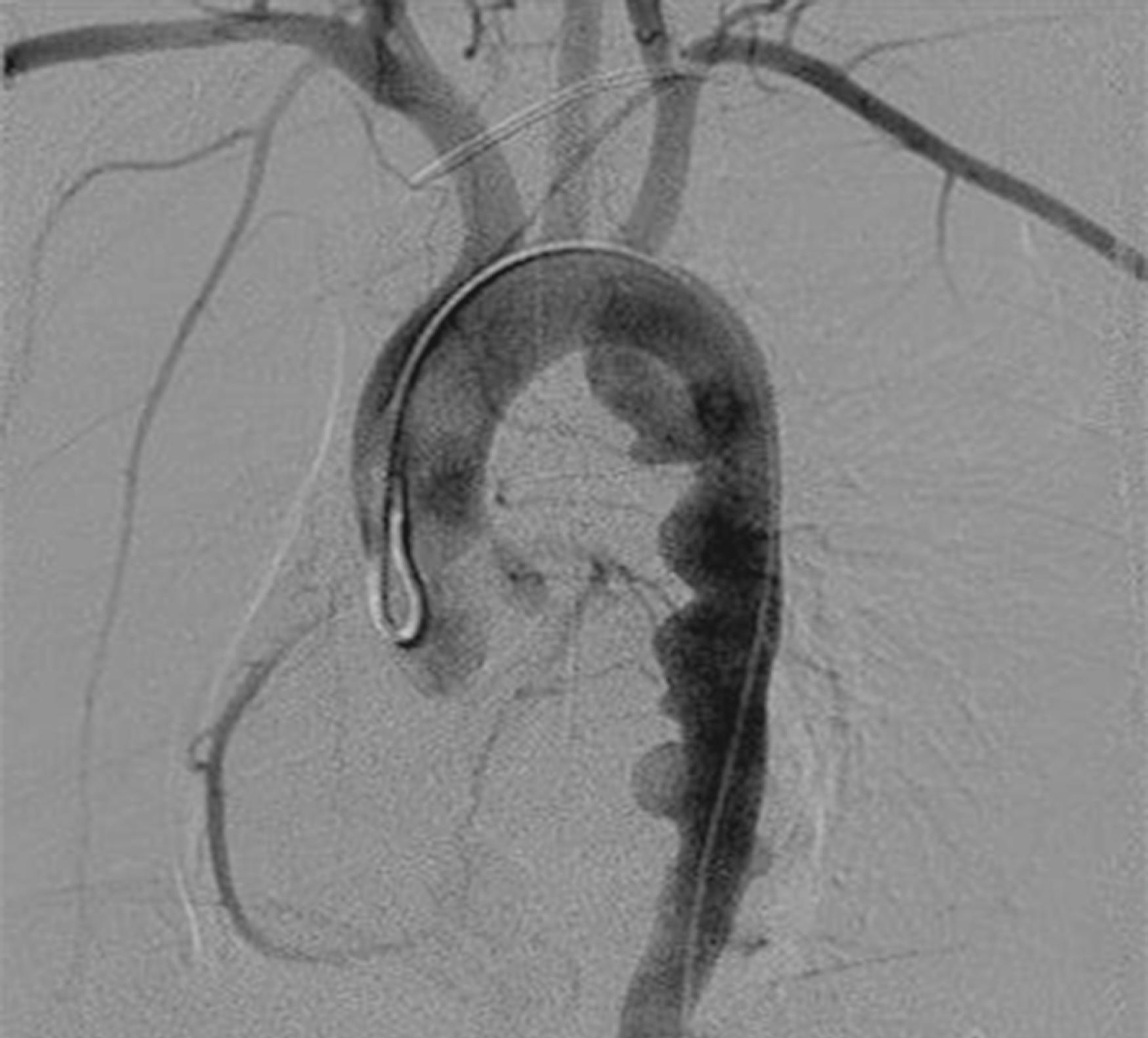
Developmental (idiopathic) aortic aneurysms are likely due to some misadventure during fetal development, without a currently recognized hereditable or spontaneous genetic etiology. , In cases of thoracic aortic aneurysms that do not meet criteria for the more common syndromic aneurysms, there are data to suggest that acceptance of a global phenotype is useful to stratify risk and guide clinical interventions, including pharmacologic means to lessen the rate of aneurysmal progression. It is noteworthy that children having other systemic features involving the craniofacial, ocular, or cutaneous tissues have aneurysms more apt to undergo rapid enlargement.
Certain developmental aortic aneurysms may be attributed to post-stenotic turbulent flow causing aortic dilation. Such aneurysms are most often observed in children with thoracic isthmic coarctations. Treatment of the latter has been by conventional open or endovascular means. Abdominal aortic narrowings caused by abnormal fusion of the embryonic dorsal aortas during the 4th week of fetal development are less common. In these children, it is likely that an unknown genetic defect, yet to be identified, results in a major fault in the vessel wall formation. Because of the frequent renal and splanchnic arterial involvement, open surgical interventions are often complex ( Fig. 186.2 ).
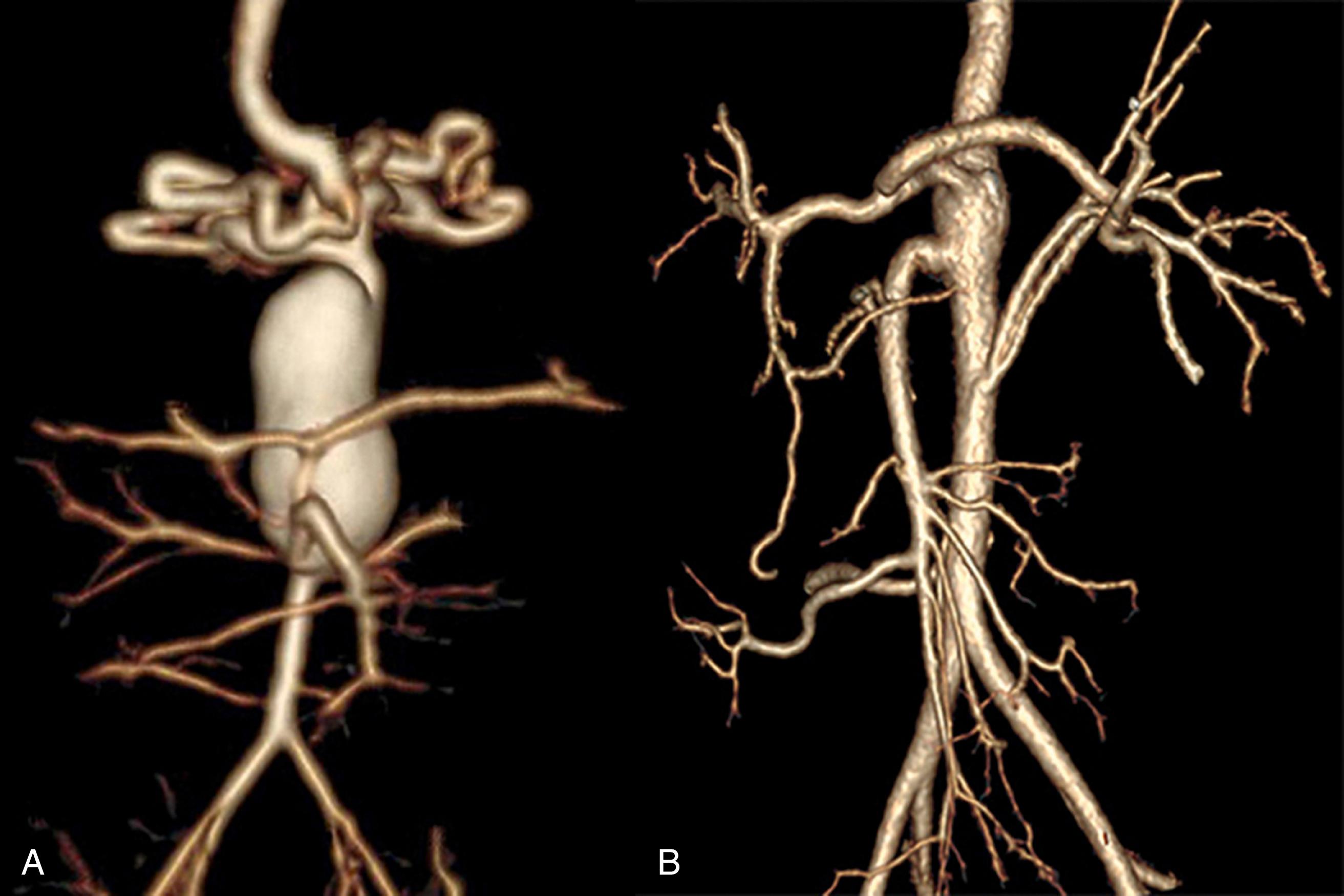
Infectious aortic aneurysms in the past accounted for nearly one-third of pediatric aortic aneurysms, but are less commonly encountered in contemporary times, most often associated with umbilical artery catheterization. Infectious aneurysms are typically saccular and may involve the thoracic aorta, abdominal aorta, and iliac vessels ( Fig. 186.3 ). Staphylococcus aureus and albus are predominant organisms responsible for these infections. These aneurysms present most commonly during the first 2 years of life. In such cases, it is critical for infection to be quiescent if a prosthetic conduit is to be used for the aortic repair. Unfortunately, such an option does not exist in the face of many acutely expanding or ruptured infected aortic aneurysms. Noniatrogenic periaortic infections are also recognized as a rare cause of childhood aortic aneurysms.
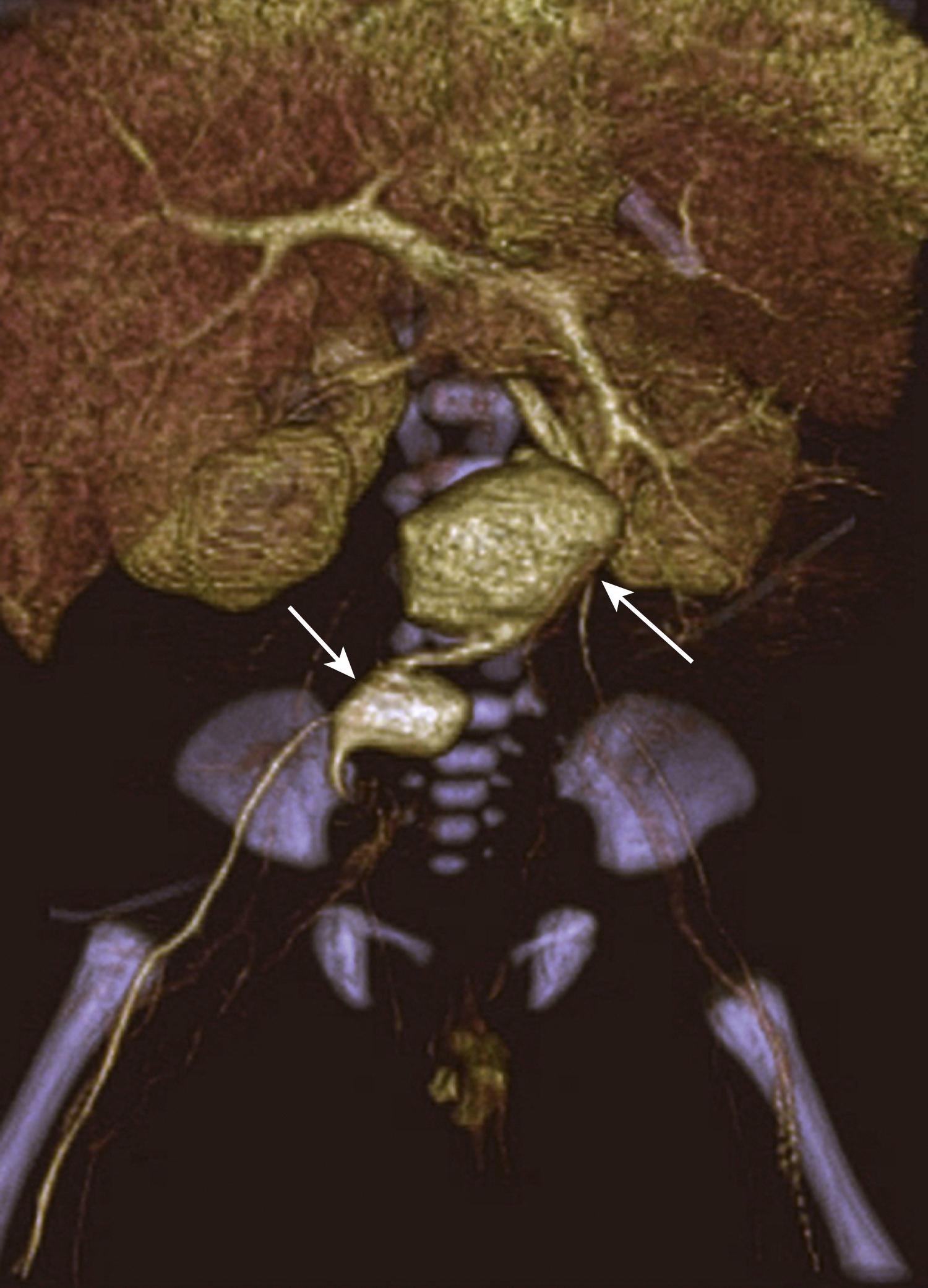
Inflammatory aortic aneurysms are uncommon, being most often attributed to Takayasu aortoarteritis and in rare instances to Kawasaki disease. Even rarer causes of pediatric aortic aneurysms are Behçet disease and systemic lupus erythematosus.
Takayasu aortoarteritis is an idiopathic, chronic, large vessel arteritis involving the aorta and its primary branches. It begins with panarteritis in the adventitia which progresses to the intima, eventually causing vascular narrowing, occlusion, and aneurysms in the later phases of the disease. Aneurysms usually affect older children and adolescents. Initial systemic manifestations of Takayasu disease include headaches, fever, and dyspnea. Hypertension with reduced carotid or femoral arterial pulses affect the majority of children. Conventional open or endovascular surgical procedures for both occlusive and aneurysmal disease occurring as a sequela of Takayasu disease may be successfully undertaken. , However, with the exception of emergencies, elective surgery should occur only in children with quiescent inflammatory disease following contemporary drug treatments. Operative interventions in the face of active inflammation markedly increase the likelihood of later anastomotic stenoses or aneurysms.
Kawasaki disease (mucocutaneous lymph node syndrome) is a systemic arteritis occurring in younger children of unknown etiology although it is thought to be triggered by an infectious agent. The latter initiate an immune response in genetically susceptible children. It is characterized by a febrile state typically with erythematous extremities, fingertip desquamation, conjunctivitis, and lymphadenopathy. The disease more commonly affects the abdominal segment of the aorta, usually during the first year of life. A critical component of Kawasaki disease is coronary artery aneurysms, affecting approximately a fifth of children with an attending risk of acute thrombosis. , Aneurysm regression with immunosuppression is well described in this disease, especially following the early administration of intravenous immunoglobulin. Aortic or peripheral arterial reconstructions should be avoided in the face of active disease at the risk of anastomotic disruption or stenosis.
Traumatic aortic aneurysms in childhood are rare, with most penetrating aortic injuries resulting in hemorrhage and death, although deceleration tears of the thoracic aorta are often contained and serve as the site of pseudoaneurysm formation. Such aneurysms may be treated with open aortic reconstructions or in select patients by endovascular means.
Open surgical interventions for aortic aneurysms in children include aneurysmectomy with interposition graft reconstructions, non-anatomic aorto-aortic bypasses, and closed or open aneurysmorrhaphy. These reconstructions are often complex, given the frequency of splanchnic or renal artery branches originating from the aneurysms. Aneurysmectomy with interposition graft aortic reconstruction is the most direct means of treating pediatric abdominal aortic aneurysms limited to the infrarenal aorta ( Fig. 186.4 ). The largest diameter graft that can safely be implanted should be used, but not one so large that slow flow along the graft’s inner surface results in the accumulation of thrombus with the potential for thromboembolism.
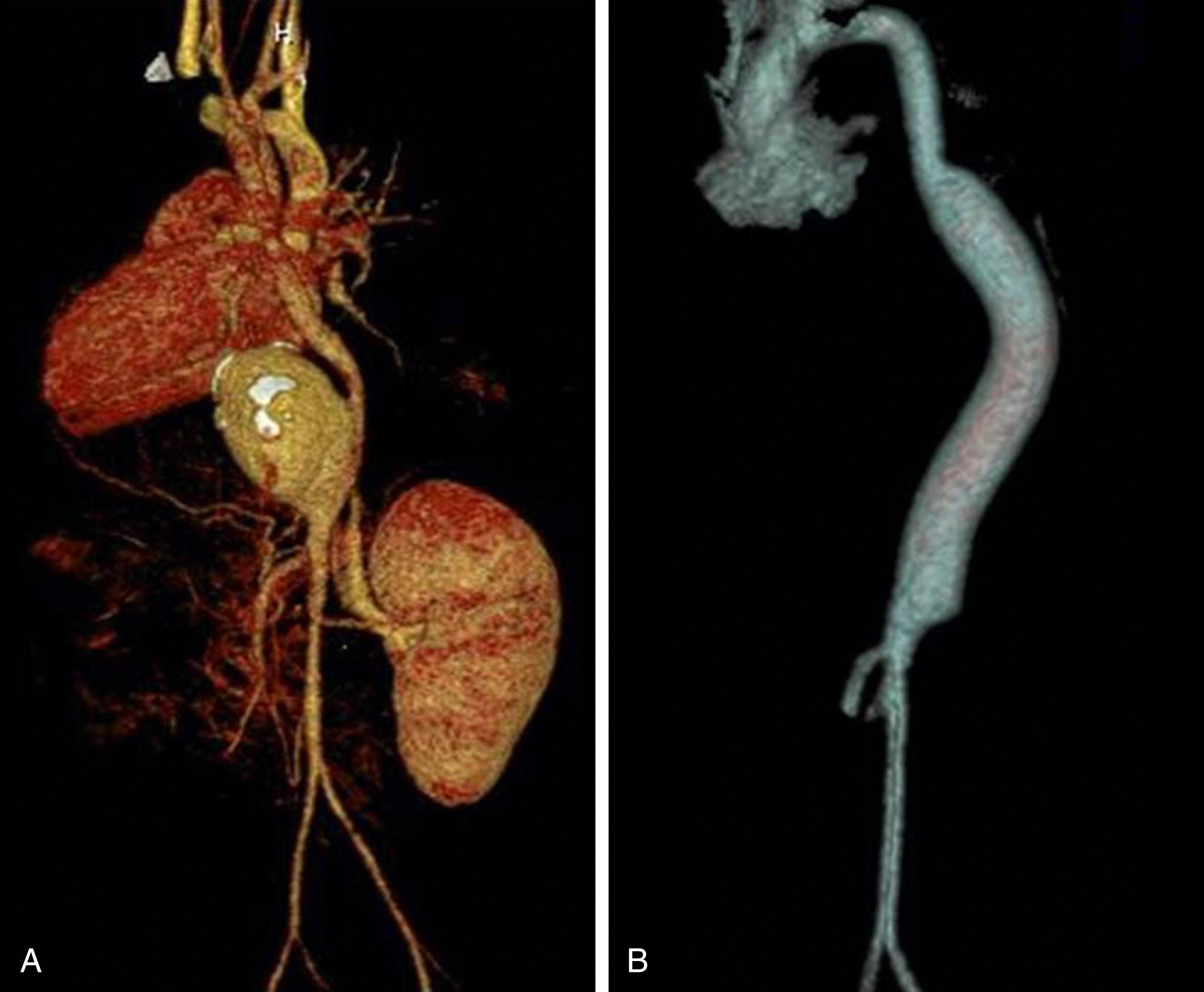
Aortic grafts placed in older children and adolescents must allow for sufficient blood flow as adulthood is reached. In infants and younger children, larger conduits permit further growth prior to the predicted need for reoperation as the child outgrows the initial reconstruction. In general, this translates to 6- to 10-mm grafts in newborns and small infants, 10- to 12-mm grafts in larger infants, 12- to 14-mm grafts in young children, and 14- to 20-mm grafts in older children and adolescents. Teflon (expanded polytetrafluoroethylene [ePTFE]) prostheses are favored over woven or knitted Dacron (polyethylene terephthalate) due to the inherent postimplantation dilation of the latter conduits. Cryopreserved homografts may be an appropriate conduit in select children, although their long-term durability has not been established. ,
Aneurysmectomy with nonanatomic aortic reconstructions in the form of thoracoabdominal or abdominal aorto-aortic and aorto-iliac bypasses are undertaken most often when splanchnic or renal arteries have their origins from the aneurysm itself, mandating their revascularization ( Fig. 186.5 ). Usually, the aortic reconstructions are undertaken first, before reconstructions of the branch arteries. This provides continuous flow to the pelvic and lower extremity tissues during respective splanchnic and renal artery reconstructions, and eventual aneurysmectomy.
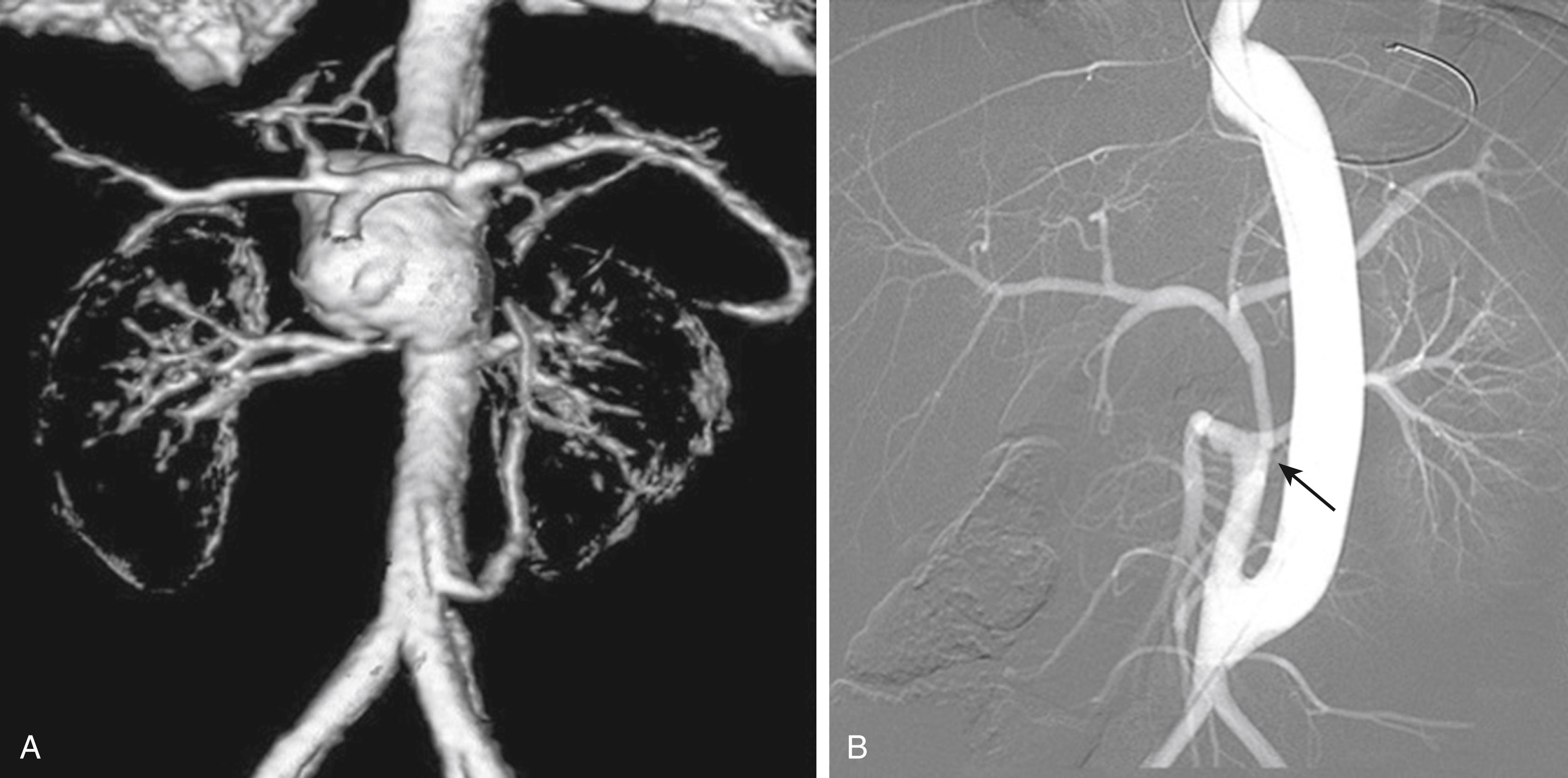
Closed or open aneurysmorrhaphy in treating pediatric abdominal aortic aneurysms is ill defined. Nevertheless, if the underlying basis of the aortic dilation can be eliminated, such as with post-stenotic aneurysms, the inexorable progression of aortic expansion following aneurysmorrhaphy may not occur. This assumes the residual aortic wall will remain stable. Although the latter may be reasonable, no long-term data exist to confirm such. Closed aneurysmorrhaphy is performed most often in treating small fusiform aortic aneurysms. Two specific circumstances negate the safe performance of closed aneurysmorrhaphy: (1) the first being the presence of thrombus or loose fibrinous debris lining the aneurysm sac, and (2) the second being an exceedingly large aneurysm, in which the plicated wall would be difficult to collapse. In the latter setting, an open aneurysmorrhaphy with excision of a portion of the wall would be more appropriate (see Fig. 186.2 ).
Endovascular aneurysm repair (EVAR) has a limited role in the definitive management of most pediatric abdominal aortic aneurysms. An exception to this tenet is the treatment of traumatic pseudoaneurysms in older adolescents in whom further aortic growth is unlikely, or in those emergent circumstances of an aortic disruption. Thoracic endovascular aneurysm repair (TEVAR) for thoracic aneurysm in select patients of appropriate age and size may be also appropriate, although caution exists in children whose aneurysm disease is a result of a progressive arteriopathy.
Surgical treatment of abdominal aortic aneurysms is successful in most infants and young children. , , This involves complex operative techniques that must take into account the child's growth potential, the aneurysm location and whether the splanchnic and renal arteries are involved. Regardless of the intervention undertaken, long-term follow-up is mandatory for all surgical interventions.
Become a Clinical Tree membership for Full access and enjoy Unlimited articles
If you are a member. Log in here